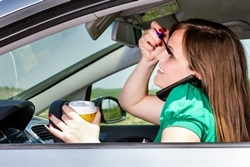When you think about distracted driving, texting and cell phone use might first come to mind. However, the AAA Foundation reports that drivers spend more than half their time focused on things other than the act of driving, and that includes distractions besides cell phone use. To avoid becoming involved in a distracted driving accident, it’s important you know why people get distracted behind the wheel and what Virginia law says about it.
Distracted Driving Isn’t Limited to Cell Phone Usage

Much of the conversation about distracted driving centers around using a cell phone because it involves three types of distraction, but anything that takes a driver’s attention away from operating a vehicle safely constitutes a distraction. The following are the three types you should know about:
- Manual distractions take a driver’s hands off the wheel. Common examples include eating, drinking, using a cell phone, using a GPS, brushing your teeth, applying makeup, changing your clothes, and fidgeting with the radio.
- Cognitive distractions impede a driver’s mental focus. Replying to a text, being on a hands-free phone call, and even thinking about the day ahead can all cause a distraction that may lead to an accident.
- Visual distractions draw a driver’s eyes away from the road. A driver who engages in cell phone use, changing the radio station, scrolling through social media sites, checking out a roadside accident, or reading a billboard all lack visual attention.
Science Can Explain Distracted Driving
Although recent scientific research has continued to highlight the dangers of distracted driving, the American Safety Council reports that 75 percent still text while driving. However, drivers must work to keep roads safe by combatting the urge to use a cell phone or engage in other manual, cognitive, and visual distractions. To do this, it’s important drivers understand why they engage in distractions, even when fully aware of the danger:
- Chemical reward. Many drivers are addicted to their cell phones. Each time they respond to a notification ping, their brain rewards that action—by releasing dopamine, a feel-good chemical. Changing the song on the radio and quenching your thirst or hunger have a similar effect.
- False self-perception. Some drivers falsely believe they are capable of multi-tasking safely, so they engage in distractions with the illusion of safety. However, the majority of drivers are incapable of multi-tasking; only about 2.5 percent of the population can handle multiple tasks at once.
Virginia Law Discourages Cell Phone Use
Although Virginia does not have a general law prohibiting distractions, it does ban texting and emailing for all drivers as a primary offense—which means an officer does not need another reason (e.g., speeding or swerving) to pull a driver over and ticket him for texting or emailing. Additionally, it is a primary offense for a school bus driver and a secondary offense for a driver under 18 to use a hand-held device while driving.
How to Prove Distracted Driving
If you believe distracted driving is to blame for your car accident, it’s prudent to contact an experienced lawyer who can help prove your case. The following are a few strategies to help you identify evidence of distracted driving after an accident:
- The police report. If you or any of your passengers saw the other driver engaging in distractions, tell the police officer. He may have evidence to support what you saw, and his report of these things will be admissible in court.
- Witnesses. After the accident, it’s important to speak with any available witnesses. A passerby may have witnessed how the accident happened, and her story may become helpful to your case.
- Cell phone records. It’s possible to gain access to another driver’s cell phone records to corroborate your story. Timestamps on text messages and phone calls may be used in court to prove the other driver was distracted at the time of the accident.
- Picture or video evidence. Witnesses sometimes catch accidents on video or in photos; a police car’s dash camera may have footage of the accident; or even traffic and surveillance cameras can show the other driver’s actions. These pieces of evidence can work in your favor.
- The at-fault driver’s confession. Sometimes, without thinking, the other driver will openly admit he was on his phone, brushing his teeth, changing the radio, or eating. If you and other witnesses hear his confession, it’s important you inform law enforcement right away.
Where to Turn After a Distracted Driving Accident Leaves You Injured
If you’ve recently been involved in a distracted driving accident and need assistance piecing together your case, the legal team at Kearney, Freeman, Fogarty & Joshi is here to speak with you. We can answer your questions and guide you through the claims process. To speak with us today, start a live online chat with one of our representatives.
|
Related links: |

